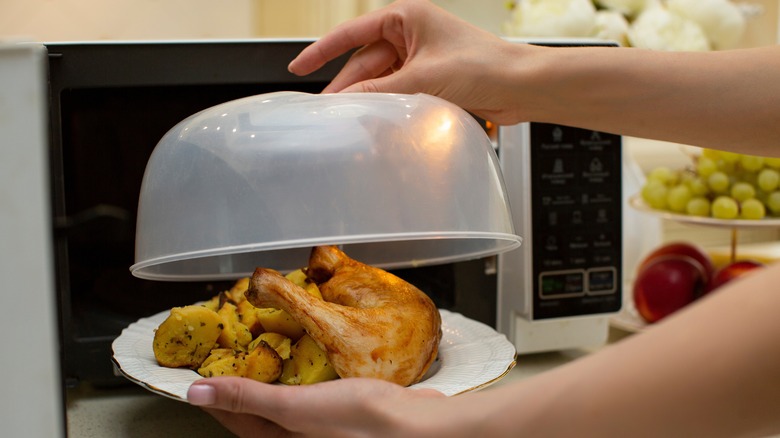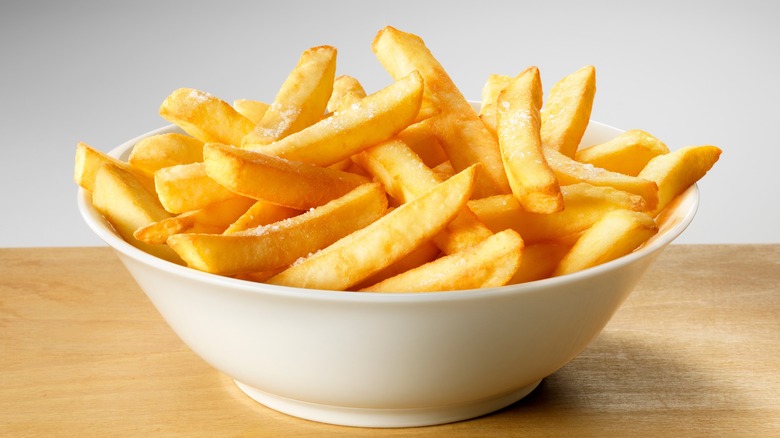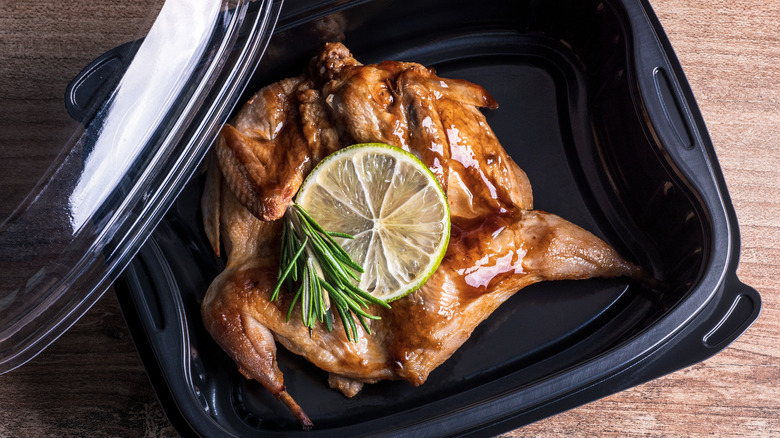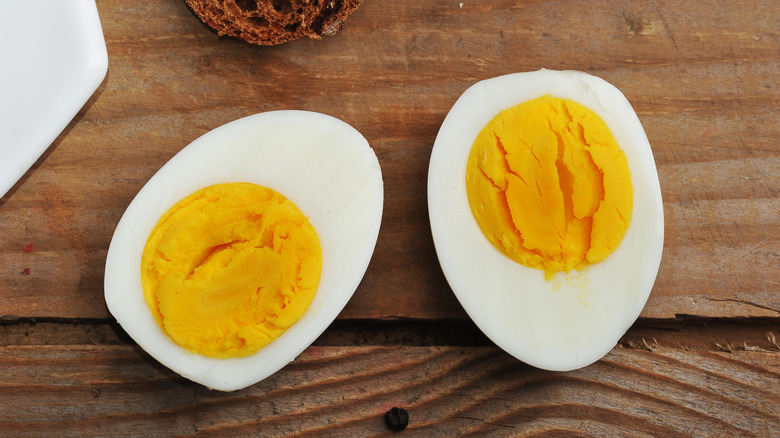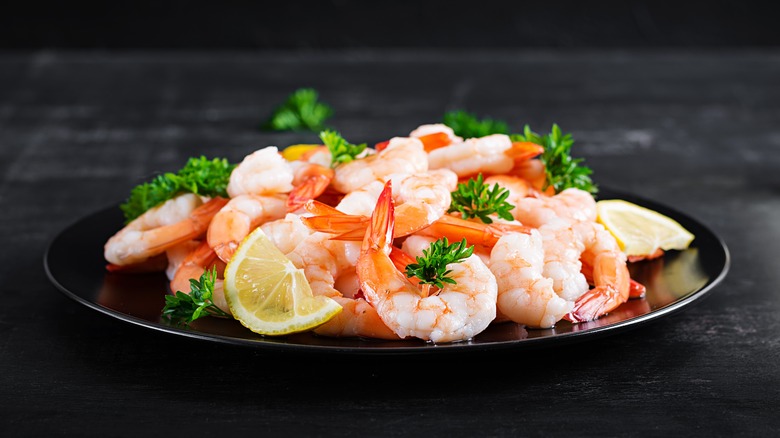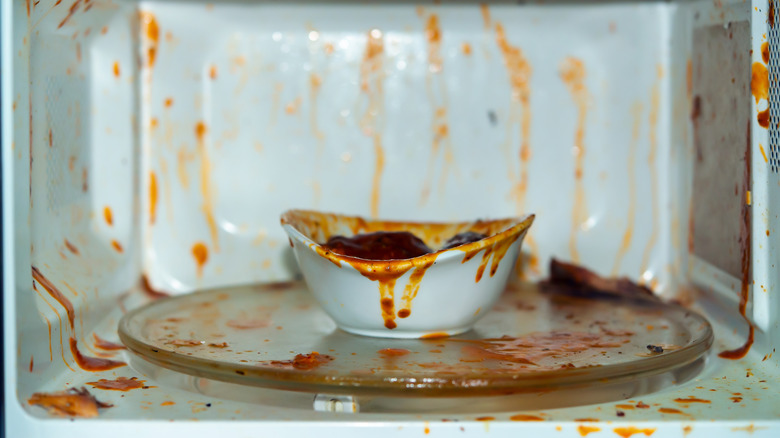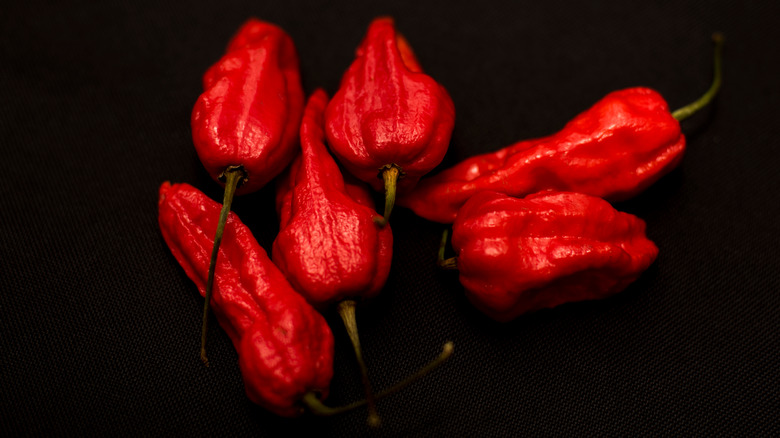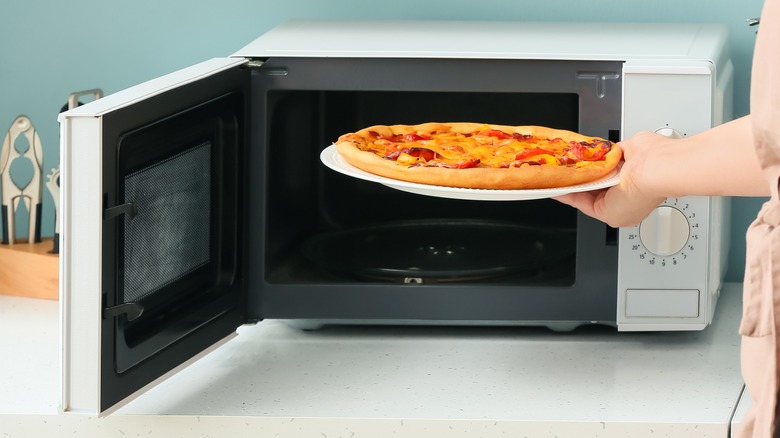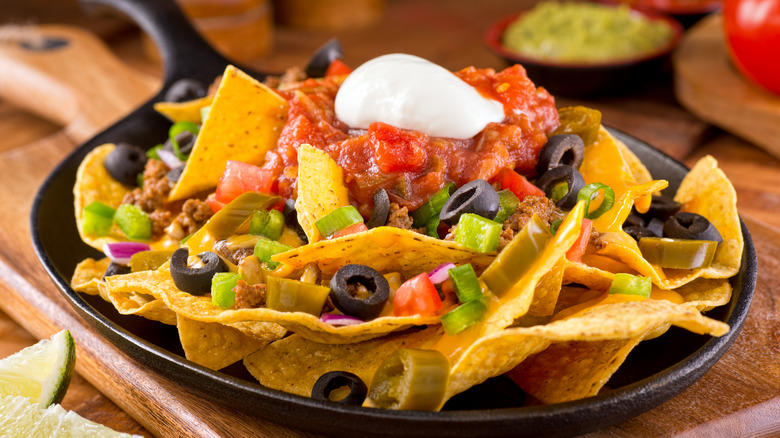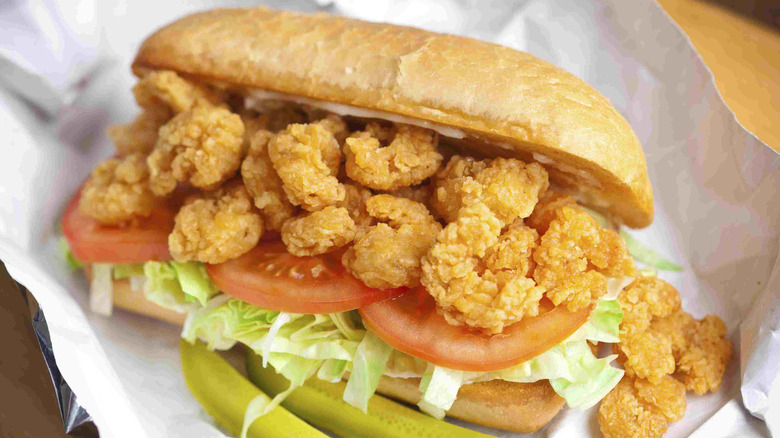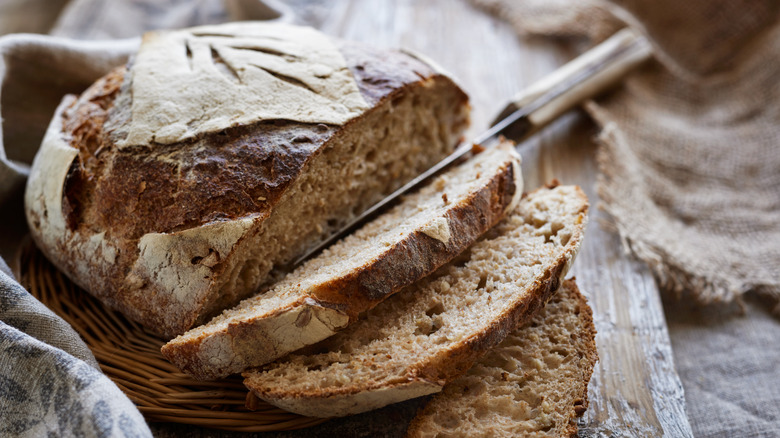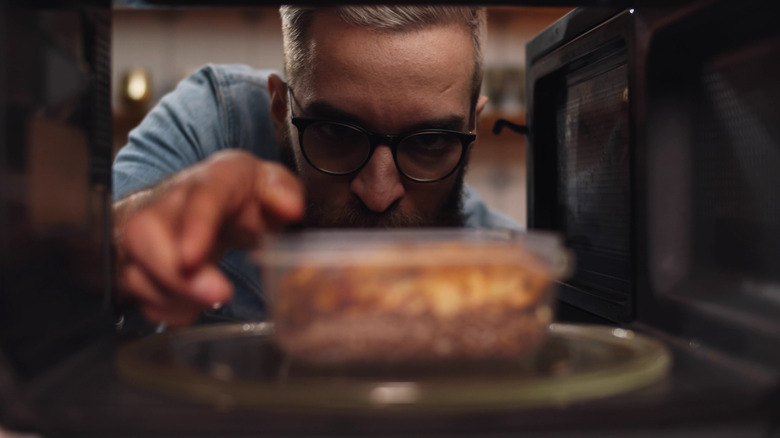11 Foods You Should Never Reheat In The Microwave
The microwave is the most mysterious and mighty of all kitchen appliances. It uses radiation, which feels kind of scary, and it works incredibly (perhaps even alarmingly) fast. It's also unique among kitchen appliances in that it's probably used more for reheating than actual cooking. Sure, you could put a raw chicken breast in the microwave and end up with something cooked in just a few minutes, but should you? Probably not. On the other hand, this strange little box is indispensable for reviving old cups of coffee and returning takeout leftovers to their former glory.
But just because you can reheat just about anything in the microwave doesn't mean you should. The powerful rays inside this appliance are too much for some foods, and you're liable to turn yesterday's delicious dinner into a sad husk of itself if you're not careful about selecting which foods you microwave, particularly if you're using a standard appliance without any bells and whistles. It's hard to beat the convenience of being able to reheat your leftovers almost instantly (and on the same plate you're eating off of, saving some dishwashing), but sometimes it's worth it to work a little harder to avoid a disappointing meal. You're an adult; you can wash one pan or turn on the oven if you have to. If you find yourself reheating any of the foods on this list, don't even think about using the microwave.
1. French fries and other fried foods
This one should require very little explanation if you've ever tried it (and who hasn't?), but anything fried and crispy becomes sad and floppy when you reheat it in the microwave. It's a real Cinderella's coach turning back into a pumpkin situation: What was once crunchy and delicious transforms into a soggy mess, sodden with grease. Instead of re-crisping, the microwave just steams fried food. This always sucks, but it's particularly heartbreaking for things like french fries that don't really have a lot of flavors and thus rely on that freshly-fried crunchy texture to make them appealing. Something like fried chicken at least has more going on in the taste department to make up for the disappointing texture (although, as we'll get to soon, microwaving chicken has its own pitfalls).
In order to revive fries from the dead, you need to use a reheating method that brings some browning to the party. Tossing them around in a dry skillet works pretty well, as does the oven (though the oven has a tendency to dehydrate fried food, so use it with caution). The best tool is probably an air fryer if you're lucky enough to have one. It will restore crunchiness to the outside of fried food, and its high heat and convection cooking allows it to do so quickly enough to avoid drying out the interior.
2. Meat
You probably wouldn't consider cooking raw meat in the microwave, which is wise. Even after meat is cooked, when it comes time to reheat, it's probably best to do so in a pan or in the oven instead of zapping it. Meats like grilled chicken or steak don't necessarily become less healthy in the microwave, but they definitely become less delicious. Depending on the meat, a couple of different factors may be at play.
If the meat you're reheating is high in polyunsaturated fatty acids (chicken is the classic example here), then reheating it in the microwave can make it take on the dreaded warmed-over flavor. This occurs when these fatty acids react with oxygen, generating undesirable flavor notes. Sometimes microwave-heated chicken can even taste like it's gone bad. Beef is lower in this type of fatty acid, so it's less prone to developing a warmed-over flavor, but it's also not a great candidate for the microwave.
Microwaving beef (especially something delicate like a medium-rare steak) should be avoided because the microwave is an incredibly powerful heat source. It's liable to overcook your beef and turn it into a rubbery disappointment. If you care about preserving the flavor and texture of your freshly-cooked meats, the oven or the skillet are much better options than nuking your leftovers.
3. Eggs
Hard-boiled eggs are a great portable snack or lunch to bring to work, but we'd recommend either eating them cold or reheating them in a bowl of warm water rather than trying to microwave them. That's because nuking a hard-boiled egg in its shell is a recipe for an explosive situation. There's a lot of water inside a hard-boiled egg, and the shell is an impervious barrier that doesn't let anything escape. As the water turns into steam, pressure builds up, and then — boom — you have an egg bomb flinging food all over the inside of your (or even worse, your communal office's) microwave.
While you may find people recommending the microwave as a good way to reheat scrambled or fried eggs, we wouldn't recommend it for the same reason we stay away from microwaving steak: The microwave is a blunt instrument. Unless you like your eggs very well done, you may be unhappy with what happens when you microwave eggs that are already cooked. Also, egg yolks heat up faster than egg whites in the microwave, leading to uneven and unsatisfactory results.
4. Fish and seafood
First, as with steak and scrambled eggs, fish and seafood are delicate proteins prone to overcooking. Have you ever tried eating overcooked squid? You might as well chew on rubber bands. This is another case where the microwave's high heat and lack of control make it less than ideal for the job — you can try reheating what started out as a perfectly-cooked fish filet and end up with something closer to seafood jerky. But even if you tweak your microwave's settings just right so you don't obliterate the fish when you reheat it, there's another important reason to avoid nuking seafood, especially in a shared microwave.
There's no getting around it — heating up fish, or seafood creates a certain oceanic odor that has a tendency to spread around a room and linger longer than anyone would like. If you reheat your fish leftovers at home and aren't bothered by the smell, more power to you, but unless you want to become everyone's least-favorite coworker, don't put yesterday's cioppino into the microwave in your office break room. Be a team player and bring less odiferous leftovers into the office for your desk lunch.
5. Tomato sauce
So far, we've covered foods that taste worse when microwaved and ones that stink up the kitchen, but tomato sauce doesn't fall into either of these categories. Instead, it will actually ruin your microwave (or at least leave you with a huge mess that will be a pain to clean up). Thick tomato sauces (especially ones that have been cooked in oil) have a tendency to literally go ballistic when nuked — they splatter, spit, and explode, coating the inside of your appliance with tomato-y goo.
This is because of the composition of tomato sauce and how that interacts with the way microwaves heat food. Pasta sauce is not uniform; instead, it's filled with pockets of solid tomato matter, water, and oil. The watery bits heat up faster than everything else, and since tomato sauce is relatively thick, the pressure of the hot steam builds until it reaches explosive potential. It's much like what happens when you try microwaving hard-boiled eggs in their shells, but perhaps even messier. The bright-red tomato splatters are annoying to clean up, and if left for too long, they can even stain the inside of the microwave. I think we've all seen communal microwaves with orange-dyed interiors that always kind of smell like pizza because they've been the victims of too many spaghetti sauce explosions.
6. Hot peppers
Do you want to make enemies out of all your neighbors? Then you should try reheating extremely spicy peppers in the microwave. One Rochester, New York resident found this out the hard way when they caused their apartment building to be evacuated by a hazmat team (via UPI). When the unnamed perpetrator of this microwave crime zapped a hot pepper, it created irritating gases that made their neighbors cough and have difficulty breathing.
The chemical that makes chile peppers spicy, capsaicin, is the same compound that makes pepper spray an effective weapon. When hot peppers are heated in the microwave, the capsaicin can spread through the air and cause you (and anyone unlucky enough to be in the vicinity) pain and discomfort. As one firefighter who responded to the scene in Rochester said, "Once it's aerosolized, if you've ever gotten pepper in your eyes, you know how hard it can be on your system."
From our experience, most common peppers probably aren't hot enough to tear gas a whole apartment building. We've microwaved jalapaños and serranos without experiencing any ill effects. Once you start dealing with the hottest peppers in the world, like the Bhut Jolokia or the Carolina Reaper, however, things might get dangerous.
7. Pizza
This might be a hot take, but you could argue that leftover pizza is actually best eaten cold. There's something great about the chew of cold cheese, and the texture of cold pizza crust is quite compelling. It's not the same as fresh, hot pizza, but evaluated on its merits, it's pretty awesome. However, we know that cold pizza is a love-it-or-hate-it thing, and many people are looking for the best way to heat up their leftover Domino's. Whatever you do, don't stick your slices in the microwave.
Microwaving pizza can go one of two ways, and both are bad. You can zap the pizza just enough to be warm, which gives you melted cheese on top of a mushy crust that's also disconcertingly wet. The other option is that you leave the pizza in the microwave a little too long, in which case you're rewarded with leathery, nigh-inedible crust and cheese that's hot enough to remove the entire roof of your mouth. The convenience of the microwave is not worth destroying the quality of a good pizza.
The good news is that there's a convenient and fast way to reheat pizza that gives you a crisp crust and cheese that's just the right temperature: Just do it in a covered skillet on the stove at moderate heat. In a few minutes, you'll have hot pizza that could almost pass for freshly baked.
8. Nachos
You might be thinking, "I make nachos in the microwave all the time, and they turn out fine," and we're sure this is true. There's nothing wrong with sprinkling some grated cheese on store-bought corn chips and nuking it for a quick and dirty TV snack. But that's not what we're talking about. We're saying that you shouldn't take your leftover nachos from the sports bar home and heat them up in the microwave.
Nachos from restaurants are often loaded with wet ingredients like sour cream, salsa, guacamole, pickled jalapeños, beans, and braised meats. All of that moisture soaks into the chips as they sit in the fridge, making them spongy and unpleasant. The microwave will do nothing to remedy that unfortunate textural situation. Also, hot guac and sour cream are honestly kind of gross. To be frank, fully-loaded nachos aren't great candidates for reheating by any method, but at least the oven or the air fryer will give you a chance to re-crisp the chips a little bit. The microwave will just leave you with a big bowl of mush.
9. Sandwiches and other foods with raw garnishes
There's something really special about foods that mix hot components with cold, fresh garnishes. A fried shrimp po' boy just wouldn't be the same without crispy lettuce and sliced tomatoes. We love what raw diced onion and cilantro do on top of a street taco. Pico de gallo and guacamole make any burrito sing. Sadly, this hot and cold contrast is best enjoyed when the food is freshly prepared; the deliciousness quickly diminishes as the garnishes heat up and the meat cools down. You're never going to recapture the magic by microwaving these types of foods, no matter how hard you try.
Microwaving a sandwich that still has the cold garnishes on it is an obviously bad move. Lettuce turns into slimy green soup in the microwave. The same goes for burritos and tacos: Microwaving guacamole is a crime, and most cold or raw vegetable garnishes lose their crisp texture and zippy flavor after they've been nuked. The only possible way to save this is to painstakingly disassemble your sandwich/taco/burrito and remove all the garnishes before microwaving the meat and bread parts and then reassembling, but this is more trouble than it's worth. The point of using a microwave is that it's quick and easy, and that goes by the wayside when you have to do burrito origami, not to mention that you'll definitely miss a few strands of lettuce and microwave them by accident. Also, there's a good chance the garnishes are already past their prime by the time you want to reheat your food anyway.
10. Bread
Another reason to steer clear of microwaved sandwiches is what the microwave does to bread. Warming up bread the right way can wake it up and make it feel almost like it's fresh-baked, but that probably won't happen if you use the microwave as a shortcut. This is because of the chemistry of starch molecules. Even if your bread has no added sugar and doesn't taste sweet at all, it still has sugar hiding in it at an atomic level. Bread is filled with starch, and starch is made from sugar atoms. If you microwave bread past 212 degrees Fahrenheit, some of the sugar that was locked inside the starch molecules can actually break down and melt. This isn't much of a problem when the bread is still hot, but when it cools down again, watch out: The melted sugar will crystallize, making the bread much harder than it was when it first went in the microwave.
You can counteract this problem somewhat if you're careful not to overheat your bread or to eat it while it's still warm. However, there's no real reason to do this when you can quickly and easily reheat bread in the oven. It only takes a few minutes, and you won't have a ticking time bomb of crystallization on your hands once the bread is hot. Nothing feels classier than serving dinner at home with a breadbasket full of rolls that you heated in the oven.
11. Foods that have already been reheated
We should note that there's some debate about this subject. Per the USDA, you can, in theory, reheat leftovers as many times as you want as long as the food reaches 165 degrees Fahrenheit and you put it back in the fridge in under two hours after heating it. Each time you do this, the food should be safe to eat for three to four days. Every new reheating resets the clock. Of course, the quality and flavor of the food will get worse during each successive cycle of reheating, but it's apparently not dangerous.
However, other sources, including this very website, say that you should never reheat leftovers more than once. This is because each time you reheat and refrigerate food, you're introducing the possibility of bacterial contamination, especially if the food takes too long to heat up or cool down (via BBC GoodFood). Are you absolutely positive that you're following proper food handling procedures every time you reheat and chill your food and that your leftovers aren't spending too much time in the temperature danger zone? If not, it's best not to tempt fate by nuking the same food over and over again. It's better to throw out old leftovers than to ruin a whole day with a nasty bout of food poisoning.
